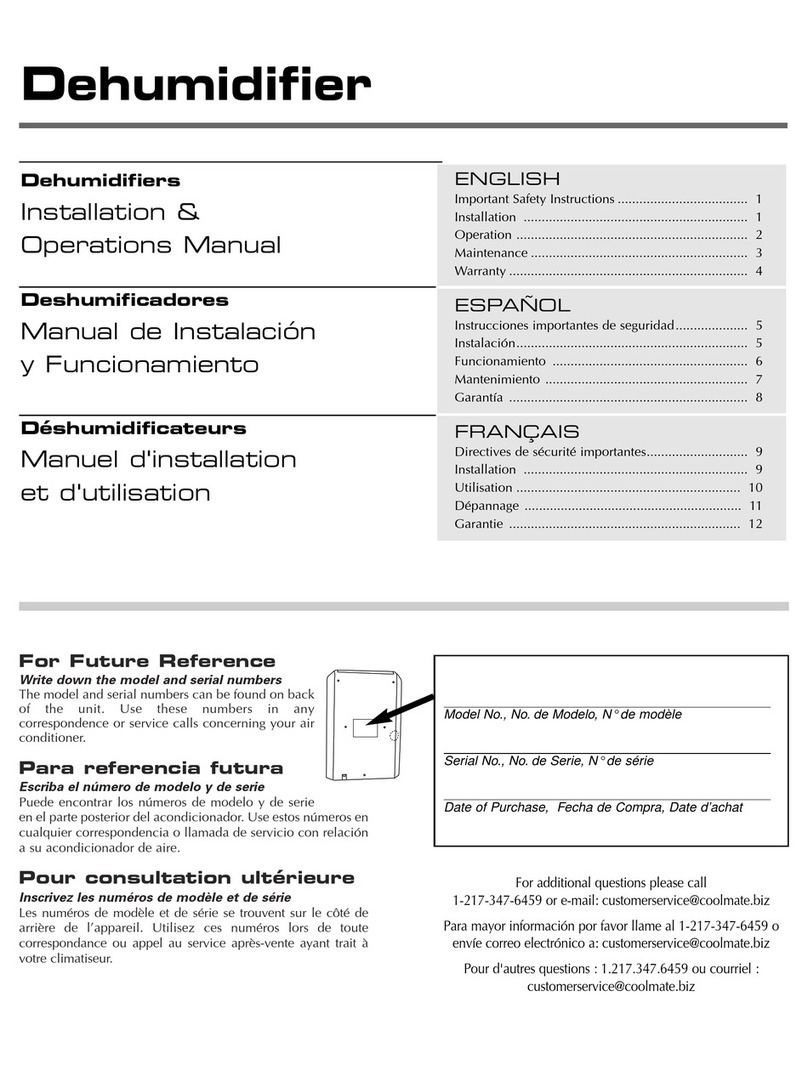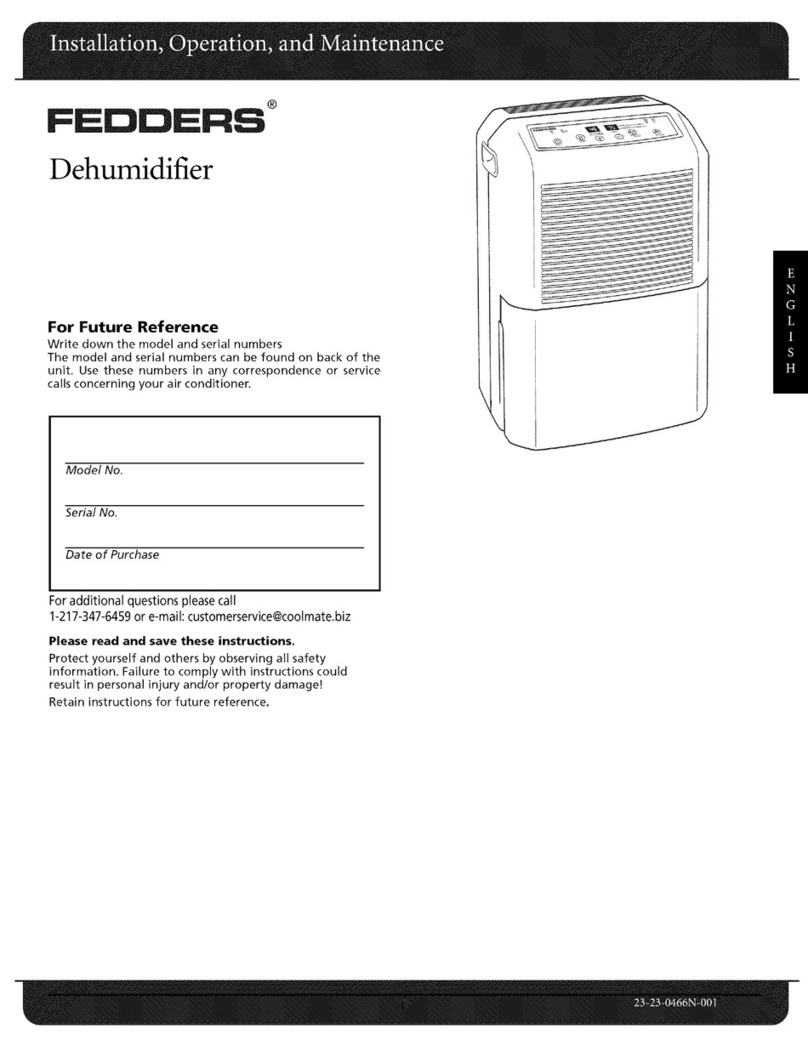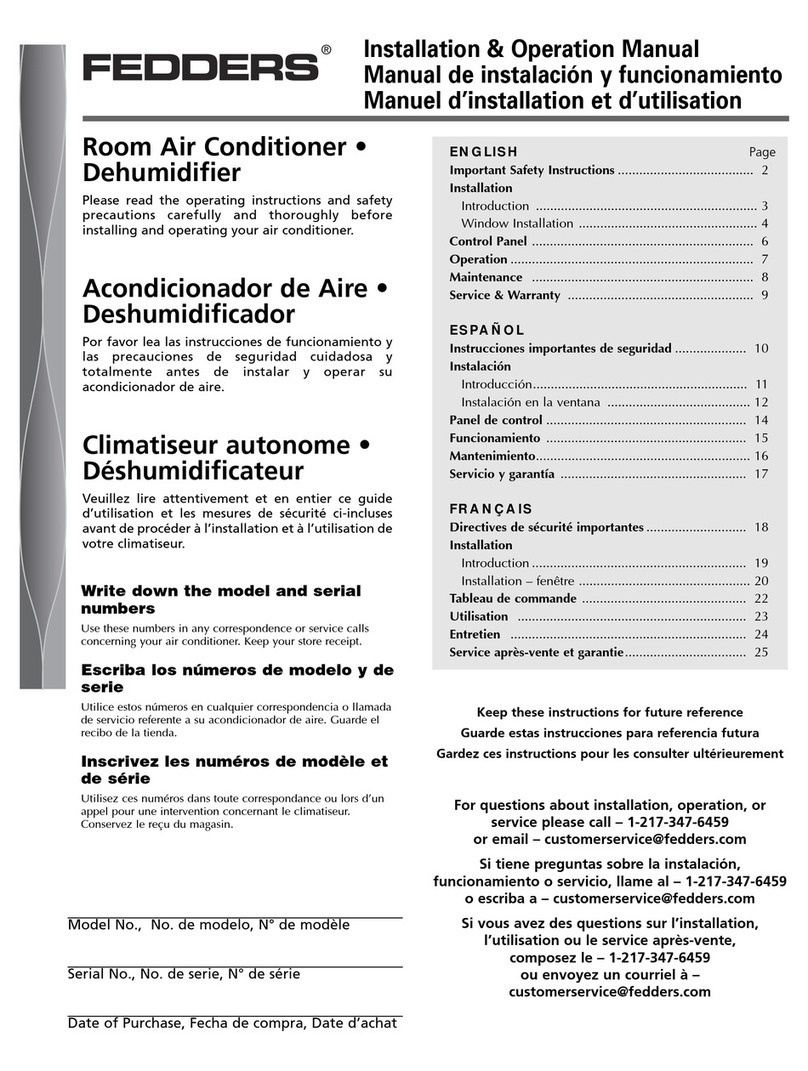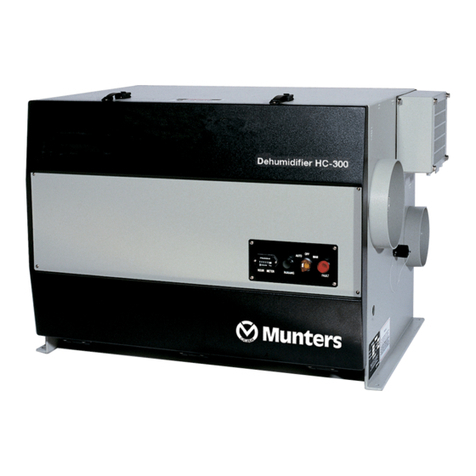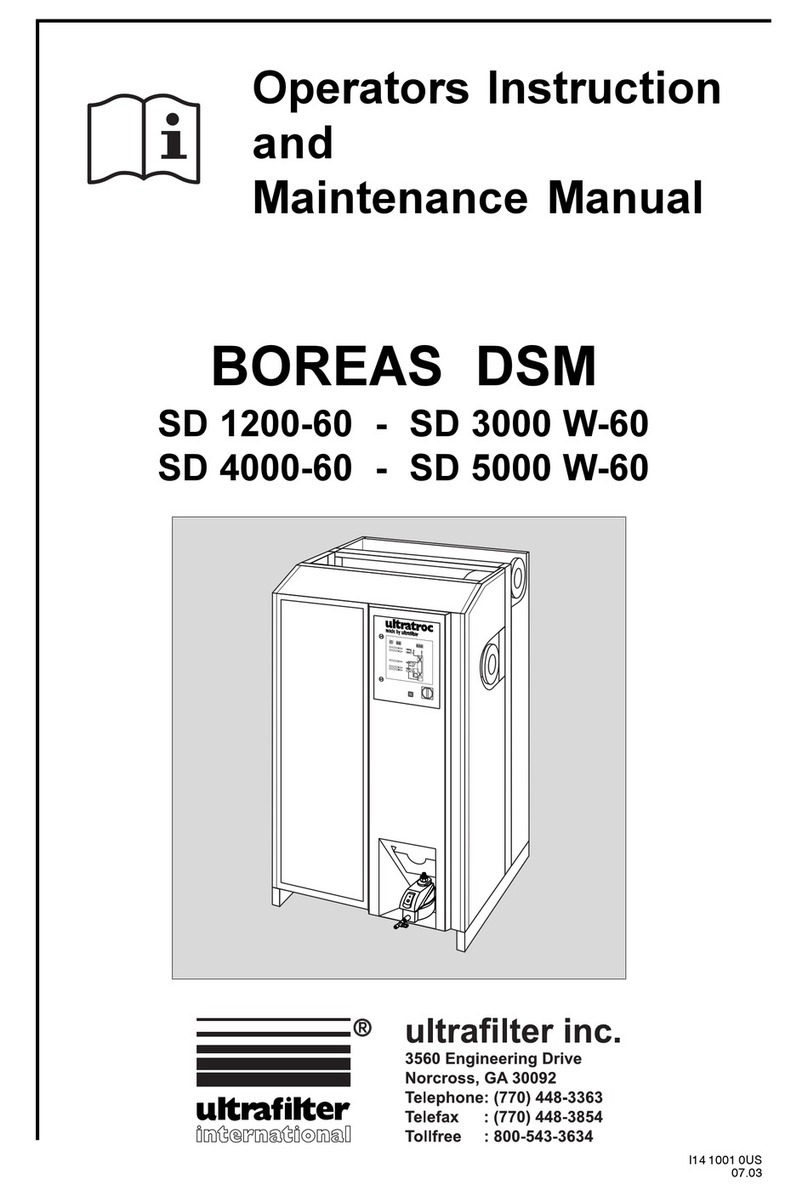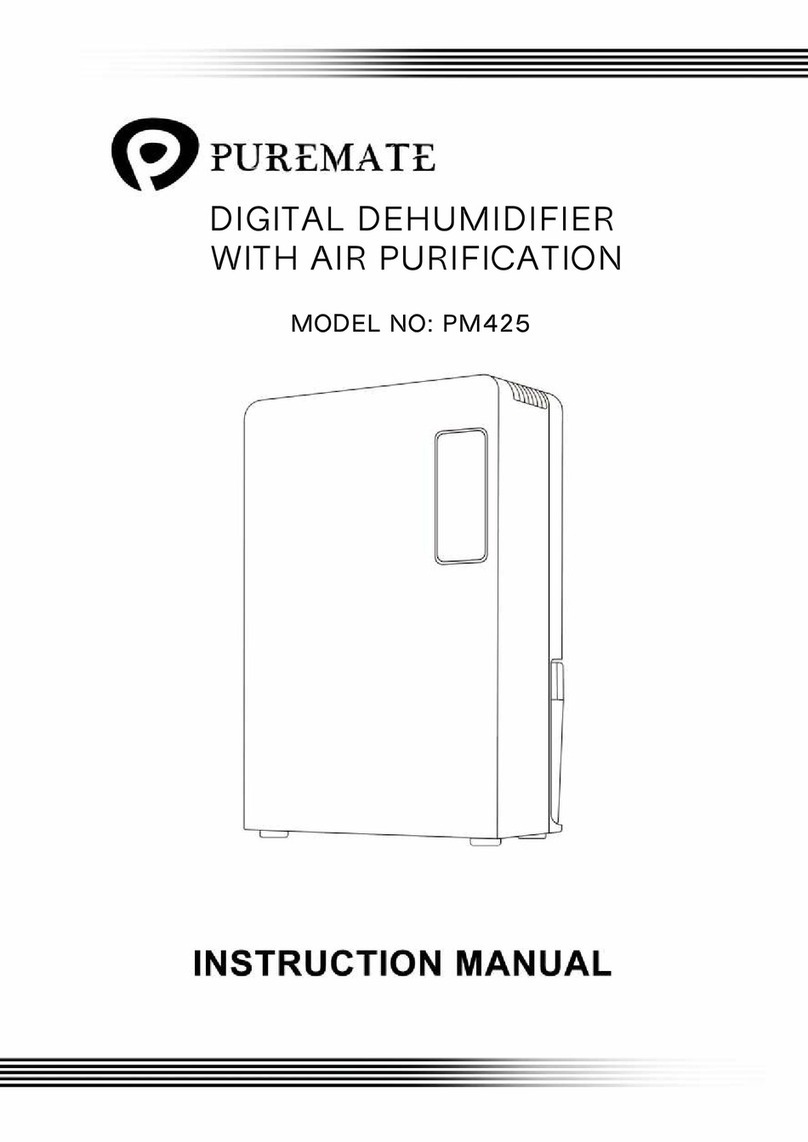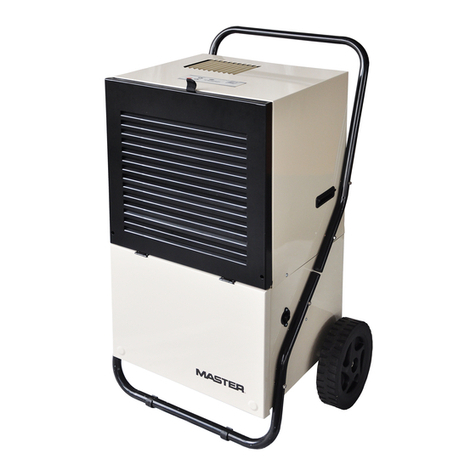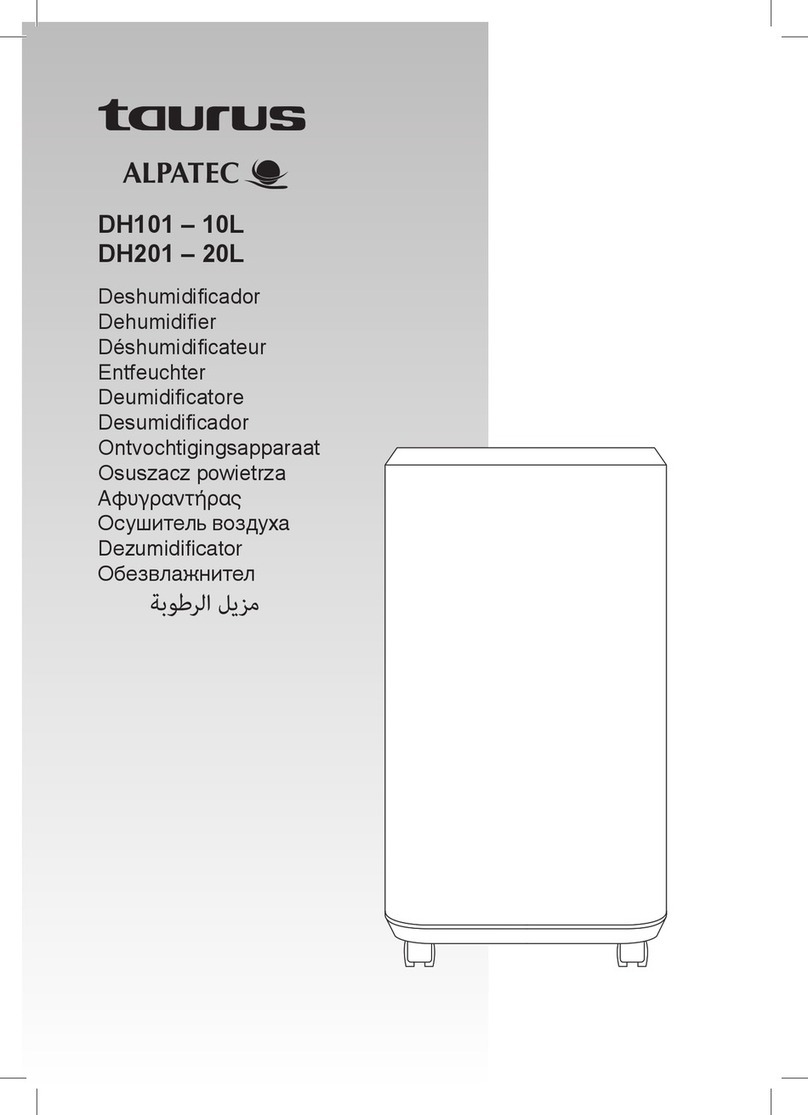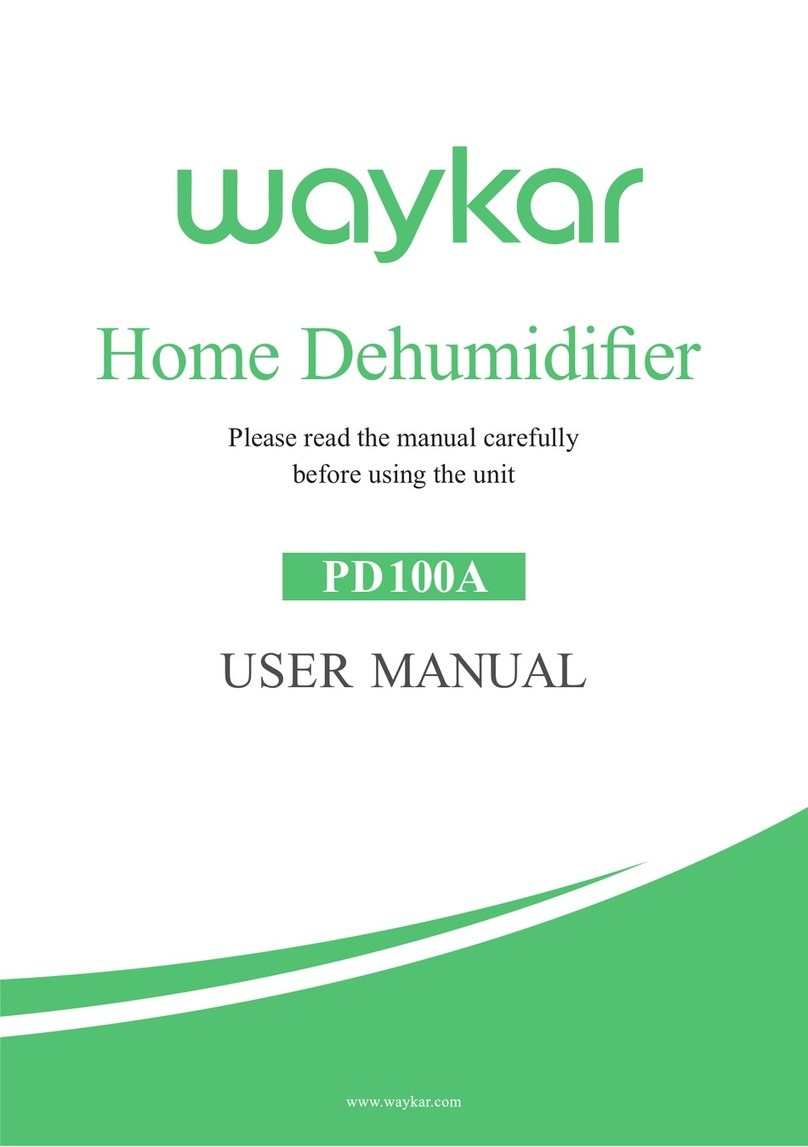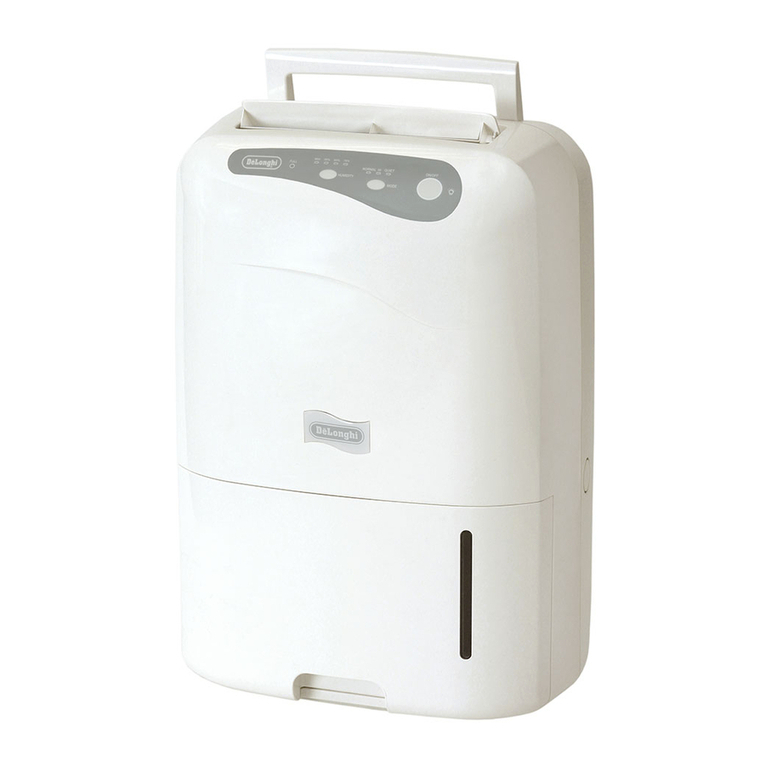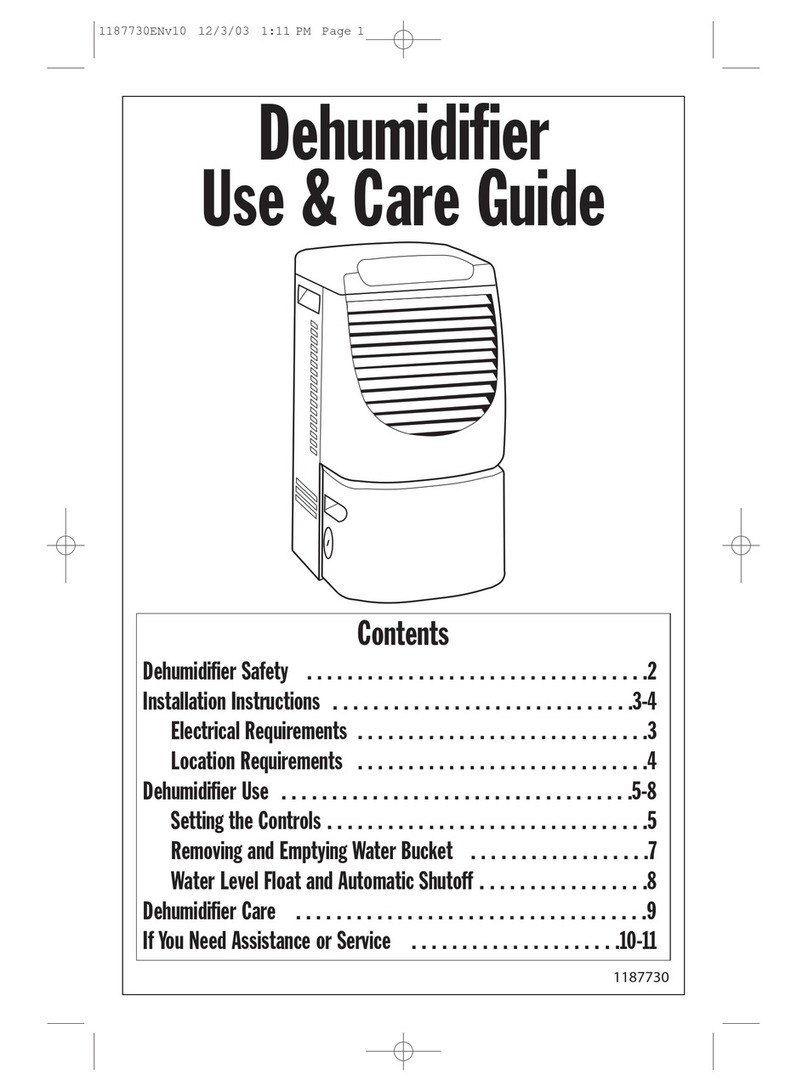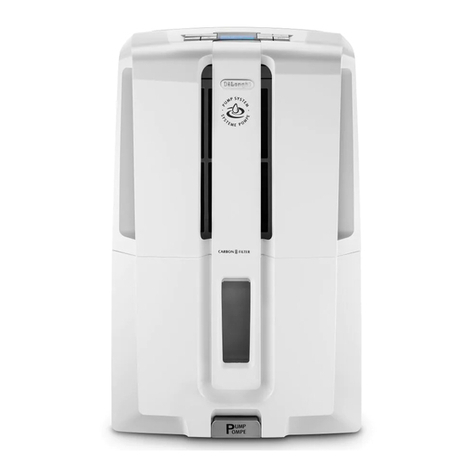Fedders Portable Dehumidifier User manual

ENGLISH Page
Important Safety Instructions ...................................... 2
Installation
Introduction .............................................................. 3
Window Installation .................................................. 4
Control Panel .............................................................. 6
Operation .................................................................... 7
Maintenance .............................................................. 8
Service & Warranty .................................................... 9
ESPAÑOL
Instrucciones importantes de seguridad .................... 10
Instalación
Introducción............................................................ 11
Instalación en la ventana ........................................ 12
Panel de control ........................................................ 14
Funcionamiento ........................................................ 15
Mantenimiento............................................................ 16
Servicio y garantía .................................................... 17
FRANÇAIS
Directives de sécurité importantes ............................ 18
Installation
Introduction ............................................................ 19
Installation – fenêtre ................................................ 20
Tableau de commande .............................................. 22
Utilisation ................................................................ 23
Entretien .................................................................. 24
Service après-vente et garantie.................................. 25
Write down the model and serial
numbers
Use these numbers in any correspondence or service calls
concerning your air conditioner. Keep your store receipt.
Escriba los números de modelo y de
serie
Utilice estos números en cualquier correspondencia o llamada
de servicio referente a su acondicionador de aire. Guarde el
recibo de la tienda.
Inscrivez les numéros de modèle et
de série
Utilisez ces numéros dans toute correspondance ou lors d’un
appel pour une intervention concernant le climatiseur.
Conservez le reçu du magasin.
Model No., No. de modelo, N° de modèle
Serial No., No. de serie, N° de série
Date of Purchase, Fecha de compra, Date d’achat
Keep these instructions for future reference
Guarde estas instrucciones para referencia futura
Gardez ces instructions pour les consulter ultérieurement
For questions about installation, operation, or
service please call – 1-217-347-6459
Si tiene preguntas sobre la instalación,
funcionamiento o servicio, llame al – 1-217-347-6459
Si vous avez des questions sur l’installation,
l’utilisation ou le service après-vente,
composez le – 1-217-347-6459
ou envoyez un courriel à –
Installation & Operation Manual
Manual de instalación y funcionamiento
Manuel d’installation et d’utilisation
Room Air Conditioner •
Dehumidifier
Please read the operating instructions and safety
precautions carefully and thoroughly before
installing and operating your air conditioner.
Acondicionador de Aire •
Deshumidificador
Por favor lea las instrucciones de funcionamiento y
las precauciones de seguridad cuidadosa y
totalmente antes de instalar y operar su
acondicionador de aire.
Climatiseur autonome •
Déshumidificateur
Veuillez lire attentivement et en entier ce guide
d’utilisation et les mesures de sécurité ci-incluses
avant de procéder à l’installation et à l’utilisation de
votre climatiseur.

2
Important safety instructions
Electrical Shock
Hazard
• Plug unit only into grounded
electrical outlet.
• Do not use an extension cord or
plug adapter with this unit.
• Do not operate unit with filter
removed.
• Failure to follow these precautions
could result in electrical shock, fire
or personal injury.
• Do not alter cord or plug end. Do
not remove warning label on cord.
Important Grounding
Requirements
Your unit will operate on any 115
volt, 3-pronged (grounded) 60 Hz
circuit. A separate line is not required,
but it is advisable not to overload the
circuit with heavy duty appliances such
as washing machines, etc.
For your safety, this unit is equipped
with a 3-pronged, grounding plug and
must be plugged into a properly
grounded outlet. If your outlet is not
of the proper type, it is your
responsibility to have the outlet and
wiring changed to the correct type. Do
not cut off the third (grounding)
prong. Do not use an adapter.
Three-prong grounding plug.
Do not alter plug end.
Single outlet grounding
wall receptacle
Grounded three-prong wall
receptacle
For Your Safety
• Do not store or use gasoline or other
flammable vapors and liquids in the
vicinity of this or any other appliance.
The fumes can create a fire hazard or
explosion.
• Do not introduce objects in the air
discharge area. This could cause
permanent damage to your unit.
• Do not pour liquids on the air
conditioner as this could cause a
malfunction. With the unit
unplugged, use a damp cloth for
cleaning your unit. This unit does
not require water or ice to be added.
• Avoid using strong solvents to clean
the air conditioner.
• Clean the air conditioner filter every
two weeks to avoid overheating
caused by air obstruction. Do not
operate without filter.
• Do not obstruct the air intake area of
your air conditioner, as this could
cause overheating, thus activating
the unit’s security switch and shutting
off the unit.
• Do not block air circulation to
exhaust tube when in use.
• Do not block air flow inside with
blinds, curtains, or furniture.
A
A
B
B
C
C
125V
15A
Power Supply:
115V, 60HZ
AC Only 1-Phase
Outlet Requirement:
3-Prong Grounding Type
125 V, 15 Amp
Minimum Wire Size:
#14 (A.W.G.) 3-Wire
Use Copper Wire Only
Circuit Protector:
15 Amp Time Delay Fuse
or Circuit Breaker
WARNING
• Do not remove or modify this plug
• Do not use as an on/off switch
• Do not use outdoors
• Do not push furniture against or place
furniture on the electrical cord. This can
trip the test switch and/or damage the
cord and become a potential condition
for arcing
• Do not attempt to repair the cord. If the
cord requires replacement, call an
authorized servicer.
•The Arc Detection Device is not a
Ground Fault Interrupter and should not
be used as such
•The Arc Detection Device contains an
electronic circuit board and should not
be submerged or exposed to water spray
Resetting
If the Arc Detection Device has tripped,
the reset button will pop up.
Follow these steps to reset the Arc
Detection Device:
1. Unplug unit from electrical outlet
2. Press the reset button
3. Plug the unit back into electrical outlet
4. Check to see if power has returned to
the unit
Testing
You should test the Arc Detection Device
equipped power cord monthly, after every
major electrical storm, or if power to your
Room Air Conditioner has been
interrupted.
Follow these steps to test the Arc
Detection Device:
1. Unplug unit from electrical outlet
2. Press the reset button
3. Plug the unit back into electrical outlet
4. Press test button. Unit should trip and
reset button will pop up.
5. Press reset button again for use
If above test fails, stop using the air
conditioner and contact customer service
by calling the following toll-free number:
1-800-332-6658
Power Cord with Arc Detection Device
The power cord supplied with this air
conditioner is equipped with an Arc
Detection Device designed to shut off
power to the unit when it senses an arc
fault condition. An arc fault is an
unintentional electrical discharge that
occurs when electrical products or wires
are damaged, aged, or improperly used.
An arc fault can be potentially hazardous
if left undetected.
Warning

3
Introduction
Before you start
• Read the instruction manual before operating the unit
for the first time. It contains important information on
operation, safety, maintenance, service and warranty.
• Do not start a damaged unit.
• The assembly and connection of the unit must be carried
out according to the instructions. If they are not
followed you run the risk of voiding the warranty.
• The power cord is located in the rear of the unit. Do not
use plug adapters or extension cords. Do not alter plug
end. Only use a grounded electrical outlet.
•Do not allow contact between the unit and water.
•Do not cover the air outlet or air intake
louvers of the unit.
• To avoid the possibility of personal injury, always
disconnect the power supply to the unit before installing
and /or servicing.
Handle
Caster
Control
Panel
Air Outlet
Drain Valve Power Cord
Exhaust Port
Serial Plate
Room
Air Intake
System
Air Intake
3
Description of Parts on the
Portable Cooling Unit
Control Panel Use the electronic control panel to select
the mode, fan speed, set the timer, or
view the current and set room
temperature.
Air Outlet The air outlet discharges the air from the
unit into the room. Use the adjustable
louvers to direct the air.
Handles Use the handles to help move the unit
around the room
Casters Allow you to move the unit from one
room to another without lifting
Room Air Intake Brings room air into the unit for cooling
or dehumidifying
System Air Intake Outside air is brought into the unit to
cool the internal components.
Exhaust Port Exhausts warm air from the internal
components to the outside.
Serial Plate Identifies unit model and serial number
Drain Valve Drains the internal condensation tank
Power Cord Uses a 3-pronged, grounding plug and
must be plugged into a properly
grounded outlet. Do not alter cord or
plug end. Do not use an extension cord.

4
Window adapter kit
Window Panel
Instructions for assembling the window adapter kit
1. Insert tube adapters through the back of the window panel.
2. Secure each tube adapter with four screws through the
front of the window panel.
3. Insert window panel extensions into window panel. Lightly
tighten the screws in the window panel to hold the
extensions in place.
Window Panel
Extension
Tube Adapters
Window Panel
Extension screws
Back of
window panel
Air Exchange Tubes
Screws
Tube Adapters
Window panel
Window panel extensions
Window adapter kit
An installation parts kit is packed with your unit in a separate
carton. Before you discard the packaging that your unit came
in, please locate the carton that contains these parts and
ensure that all parts are present.
Window panel Attaches to window opening to
allow air exchange for system air
transfer.
Window panel extensions Extends window panel to fit
windows of various dimensions.
Tube adapters Connect Air exchange tubes to
window panel.
Screws 12 screws are included for
assembling the window adapter
kit. Some screws may be partially
assembled onto window panel.
Air exchange tubes Exchanges air between the unit
and outdoors.
4
5
6

5
Window installation
Maintain a clear distance (from walls, furniture, etc.)
of at least 10 inches around the unit to allow proper
air circulation and prevent damage to the unit.
Important: Do not over-stretch the exhaust tube or
make any unnecessary bends in it.
Installing the window adapter kit
Note: The window adapter kit must be installed and
connected for the air conditioner to work properly in
Cool mode. The window adapter kit is not required
when using the unit in Dehumidify, or Fan modes.
Your window adapter kit has been designed to fit
most standard vertical and horizontal window
applications. However, it may be necessary for you to
improvise/modify some aspects of the installation
procedures for certain types of windows.
1. Open window. (fig.A)
2. Place window panel with extensions into window
frame and adjust to width of window. (fig.B)
Window adapter kit may be installed vertically as
well as horizontally. This installaton may also be
used for crank style windows. (fig.E)
3. Tighten the four screws on the window panel to
secure the window panel extensions.
4. Close window. (fig.C)
5. The window adapter kit should now fit securely
within the window frame and you can now attach
the air exchange tubes. If you are having trouble
attaching the air exchange tubes, you may attach
the tubes prior to installing the window adapter kit.
Attaching the air exchange tubes to the air
conditioner
1. Attach the tubes to the window adapter kit.
2. Attach the other end to the air conditioner.
To attach air exchange tubes: push tube onto tube
adapter and twist until the tab is in place in the hole
on the tube.
To remove air exchange tubes: twist the end until the
tab is clear of the hole in the tube and pull off.
Do not attach the tubes if using the unit in
dehumidify.
A
D
E
C
B
Vertical installation
7
89

6
Control Panel
Power Control
The power control turns the unit on and off.
Warning Light
Condensed water may accumulate in the unit. If
the internal tank becomes full, the Warning Light
will shine and the unit will not operate until the
unit has been drained. See Draining Excess Water
section for instructions on how to drain the water.
Mode Control
The Mode Control has 3 settings:
Cool, Dehumidify and Fan.
The settings are adjusted with the Mode Control
button. A light will indicate which setting is
currently being used.
Cool Mode
When Cool mode is selected, the indicator
light will shine green. During the cooling
mode the air is cooled and hot air is
exhausted to the outside air through the
exhaust tube. Adjust fan speed and
temperature to suit your desired comfort
level. Note: The air exchange hoses must
vent outside the room when using Cool
Mode.
Power
Control Mode
Control
Warning
Light
Fan Speed
Control Timer
Control
Display
Mode
Indicators Timer/Temp Set
Controls
Display
Dehumidify Mode
When Dehumidify mode is selected, the indicator
light will shine orange. Air is dehumidified as it
passes through the unit, without being in full
cooling mode. The fan will operate in Med speed.
Fan speed is not adjustable in Dehumidify mode.
Note: The air exchange hoses must vent inside the
room when using Dehumidify Mode.
Fan Mode
When Fan mode is selected the LED light will shine
yellow. Air is circulated throughout the room with
no cooling. (Note: unit does not need to be vented
in Fan mode.)
Fan Speed Control
The Fan Speed Control has 3 settings:
High, Medium, and Low.
Timer Control
Auto turn off:
With machine in fan mode, press timer button to
select number of hours you would like the unit to
run in air conditioning mode until it automatically
shuts off.
Auto turn on:
With machine powered off, press timer button to
select number of hours until you would like the
unit to automatically start running in air
conditioning mode.
Temp/Timer Set Controls
Used for adjusting the timer and thermostat.
The default display is room temperature.
When “+” or “-” button is pressed the set temperature
is displayed and may be adjusted. After 15 seconds the
display will revert back to room temperature.
Note: By pressing both Temp/Timer Set buttons
at the same time, the display will toggle
between Celsius and Fahrenheit.

7
Operation
Operating Instructions
Air Conditioner /Cool Mode
1. Install the widow adapter kit and hoses to the unit.
2. Press the On/Off button to turn the unit on. The unit will
power up and display the room temperature.
3. Press the Mode button until the green indicator light shines.
4. Press the Temp/Timer Set buttons to set the desired
temperature. While you are adjusting the setting, the Set
Temperature indicator will shine and the display will show
the set temperature. After you have finished adjusting the
temperature, the display will default back to the room
temperature and the “Room Temp” indicator will shine.
5. Press the Fan Speed button to select the desired setting
(High, Med, Low). The fan speed indicator light will shine
for the selected speed.
6. Condensed water may accumulate in the unit. If the internal
tank becomes full, the warning light will shine and the unit
will not operate until the unit has been drained. See
Draining Excess Water section for instructions on how to
drain the water.
7. Once the room reaches the set temperature, the compressor
will turn off and the fan will continue to operate.
Dehumidify Mode
1. Press the On/Off button to turn the unit on. The unit will
power up and display the room temperature.
2. Press the Mode button until the orange indicator light
shines above the word Dehumidify.
3. Condensed water may accumulate in the unit. If the
internal tank becomes full, the warning light will shine
and the unit will not operate until the unit has been
drained. See Draining Excess Water section.
4. The fan will operate in Med speed. Fan speed is not
adjustable in Dehumidify mode.
Fan Mode
1. Press the On/Off button to turn the unit on. The unit will
power up and display the room temperature.
2. Press the Mode button until the yellow indicator light
shines.
3. Press the Fan Speed button to select the desired setting
(High, Med, Low). The fan speed indicator light will shine
for the selected speed.
4. The unit will operate continuously in Fan mode.
Timer
The timer can be set to turn the unit off or on. The timer is
adjustable between 1 and 12 hours.
To turn unit off automatically:
1. With unit running in desired mode, press timer button.
2. Use Temp/Timer Set buttons to select number of hours
you would like the unit to run until it automatically
shuts off. After you have finished adjusting the timer,
the display will default back to the room temperature
and the “Room Temp” indicator will shine. Timer
indicator will blink when set. To turn timer off press the
timer button.
To turn unit on automatically:
1. With unit powered on select desired mode and fan
speed, then power unit off.
2. With machine powered off, press timer button to select
number of hours until you would like the unit to
automatically start running in air conditioning mode.
Timer indicator will blink when set. The display will
show the number of hours the unit is set until it begins
operation. To turn timer off press the timer button.
Before starting this unit
1. Select a suitable location, making sure you have a level surface with no obstructions, and easy access to an electrical outlet.
2. Install the window adapter kit, as described in the Installation section.
Note: The window adapter kit is required only while using the Cool mode.
3. Plug the unit into a grounded electrical outlet. Do not use an extension cord.

8
Maintenance
Draining excess water
Condensed water may accumulate in the unit. If the
internal tank becomes full, the Warning Light will shine
and the unit will not operate until the unit has been
drained.
First, uplug electrical cord from wall outlet. Then, drain
excess water from the tank by placing a pan under the
drain valve, removing the drain plug, and letting the
water drain into the pan.
When the water stops draining out, replace the drain
plug, and remove the pan of water. Operate the air
conditioner in fan mode to dry the interior of the unit.
Always drain the unit before putting it into storage.
Cleaning and Maintenance
• The unit has an air filter that must be cleaned with
water every two weeks and put back in the unit after it
is completely dry.
• The air discharge grille can be cleaned with a rag or
sponge, warm water and mild detergent.
• Never use hot water, bleach, gasoline, acids, cleaning
fluid or a brush to clean the unit. This will damage the
cabinet and the air discharge area.
• Do not wash the unit with a hose.
Cleaning the filter.
1. Turn Power OFF.
2. Remove the air filter by grasping the bottom and
pulling it up and out of the unit.
3. Wash in hot soapy water, rinse and shake dry.
4. Replace the filter with the front of the filter toward you.
5. To dry the filter thoroughly, run your unit in fan mode
for a few minutes. Remember, only a clean filter works
properly and delivers top efficiency at every setting.
Air Conditioner Remote Control
AAA IEC R031.5V
+-
AAA IEC R03
1.5V
The functions work the same as your air conditioner’s
touch controls.
Batteries: Remove the cover on the back of the remote
controller and insert the batteries with the (+) and (-)
poles pointing in the proper direction.
Drain Valve
Warning: Make sure unit is unplugged before
performing any maintenance procedure.
Proper use and care of
your air conditioner will
help ensure longer life of
the unit. It is
recommended to have a
professional annually
inspect and clean the coils
and condensate water
passages. Expense of
annual inspection is the
consumer’s responsibility.
CAUTION:
• Use only AAA or IEC R03 1.5V batteries.
• Do not attempt to recharge the supplied batteries
• All batteries should be replaced at the same time.
• Do not dispose of the batteries in a fire as they may
explode.
• Do not mix old and new batteries.
• Do not install the batteries with the polarity (+/–)
reversed.
• Do not mix alkaline, standard (carbon - zinc), or
rechargeable (nickel-cadmium) batteries.
• Keep batteries and other things that could be
swallowed away from young children. Contact a
doctor immediately if an object is swallowed.
10
11
CAUTION
Failure to keep air filter clean will result
in poor air circulation. DO NOT operate
without filter. This can render the unit
inoperative.
Removing the filter

9
Service & warranty
To locate your nearest Service Center, call 800-332-6658.
For models installed in North America – If service
or parts are required
First, make the recommended checks. If it appears that service or parts are still required,
see your warranty “How to Obtain Warranty Service or Parts”. Please have the model
number and serial number with you when calling.
For models installed
outside of North America
For models purchased for use outside North America, the manufacturer does not extend
any warranty either expressed or implied. Consult your local dealer for any warranty
terms extended by the importer in your country.
Warranty
Within the 48 contiguous United States, State of Hawaii, the district of Columbia, Puerto Rico and
Canada
Full (One) Year Parts and Labor Warranty
During the first year after the date of original purchase, Fedders Appliances will, through
a network of authorized servicers and free of charge to the owner or any subsequent
user, repair or replace any parts which are defective in material or workmanship due to
normal use when the unit is delivered by the owner to and picked up from one of our
authorized servicers. If requested, in-home service, pick-up, redelivery and reinstallation
will be provided, but are the owner’s responsibility.
Limited (Second through Fifth Year)
Sealed System Warranty
If any part of the sealed refrigerant system (consisting of compressor, evaporator,
condenser, and interconnecting refrigerant tubing) should fail because of a defect in
material or workmanship (including refrigerant charge), within the second through fifth
year from the date of original purchase, Fedders Appliances, through a network of
authorized servicers, will repair or replace such part, including labor, at no cost to the
owner when the unit is delivered by the owner to and picked up from one of our
authorized servicers. If requested, in-home service, pick-up, redelivery and reinstallation
will be provided, but are the owner’s responsibility.
Note: In the event of any required parts replacement within the period of this warranty, Fedders
Appliances replacement parts shall be used and will be warranted only for the period remaining on
the original warranty.
Exceptions
The above Limited Warranties do not cover failure to function caused by damage to the
unit while in your possession (other than damage caused by defect or malfunction), or
by its improper installation, or by unreasonable use of the unit, including without
limitation, failure to provide reasonable and necessary maintenance or to follow the
written Installation and Operating Instructions. If the unit is put to commercial, business,
rental, or other use or application other than for consumer use, we make no warranties,
express or implied, including, but not limited to, any implied warranty of
merchantability or fitness for particular use or purpose.
THE REMEDIES PROVIDED FOR IN THE ABOVE EXPRESS WARRANTY ARE THE SOLE AND
EXCLUSIVE REMEDIES THEREFOR, NO OTHER EXPRESS WARRANTIES ARE MADE ALL IMPLIED
WARRANTIES, INCLUDING BUT NOT LIMITED TO ANY IMPLIED WARRANTY OF
MERCHANTABILITY OR FITNESS FOR
APARTICULAR USE OR PURPOSE, ARE LIMITED IN DURATION TO ONE YEAR FROM THE DATE
OF ORIGINAL PURCHASE. IN NO EVENT SHALL FEDDERS APPLIANCES BE LIABLE FOR
INDIRECT, INCIDENTAL, OR CONSEQUENTIAL DAMAGES, EVEN IF ADVISED IN ADVANCE OF
THE POSSIBILITY OF SUCH DAMAGES. NO WARRANTIES, EXPRESS OR IMPLIED, ARE MADE TO
ANY BUYER UPON RESALE.
Some states do not allow limitations on how long an implied warranty lasts or do not
allow the exclusion or limitation of incidental or consequential damages, so the above
limitations or exclusions may not apply to you. This warranty gives you specific legal
rights, and you may also have other rights which may vary from state to state.
No warranties are made for units sold outside of the above stated areas. Your distributor
or final seller may provide a warranty on units sold outside of these areas.
How to obtain Warranty Service or Parts
Service for your unit will be provided by CareCo, with
authorized independent CareCo servicers nationwide.
Note: Before calling for service, carefully read the Installation and
Operating instructions booklet.
Then if you need service:
1. Call a CareCo authorized servicer and advise them of
model number, serial number, date of purchase and
nature of complaint. Service will be provided during
normal working hours. Contact your dealer for the name
of an authorized servicer if unknown to you.
2. If your dealer is unable to give you the name of a
servicer or if you need other assistance, call the
following toll-free number for the name of an authorized
servicer or authorized parts distributor:
1-800-332-6658
or you may write:
CareCo, Service Department
415 W. Wabash Ave., P.O. Box 200
Effingham, IL 62401
Proof of Purchase Date
It is the responsibility of the consumer to establish the original
purchase date for warranty purposes. We recommend that a
bill of sale, cancelled check, or some other appropriate
payment record be kept for that purpose.

10
Instrucciones importantes de seguridad
Riesgo de
Choque Eléctrico
•Enchufe el aparato
solamente en un tomacorriente
eléctrico puesto a tierra.
•Con este aparato no use un cordón de
extensión ni un adaptador de enchufe.
•No haga funcionar el acondicionador
de aire sin el panel delantero.
•El incumplimiento de estas
precauciones pueden causar un choque
eléctrico, incendio o lesión personal.
•No modifique el cordón ni el enchufe
del extremo.
Requisitos importantes
para la conexión a tierra
Su unidad funcionará en cualquier
circuito de 115 voltios, de 3 patillas (con
conexión a tierra) y 60 Hz. No se requiere
línea separada, pero es aconsejable no
sobrecargar el circuito con artefactos que
usan mucha corriente como máquinas de
lavar ropa, etc. Para su seguridad, esta
unidad está equipada con un enchufe de
3 patillas de conexión a tierra y debe
enchufarse en un tomacorriente con la
debida conexión a tierra (Figuras 1 y 2).
Si su tomacorriente no es del tipo
adecuado, usted tiene la responsabilidad
de hacer que se cambien tanto el
tomacorriente como los alambres al tipo
adecuado.
No corte la tercera patilla de conexión a
tierra. No use un adaptador.
Para su seguridad
•Noguarde ni use gasolina u
otros vapores y líquidos
inflamables en la vecindad de
este o cualquier otro artefacto.
Los vapores emitidos pueden
crear un riesgo de incendio o
explosión.
•No introduzca objetos en el
área de descarga del aire. Esto
puede causar daño irreparable
a su acondicionador de aire.
•No vierta líquidos de limpieza
en el acondicionador de aire
pues esto puede causar un
malfuncionamiento. Use un
paño húmedo para limpiarlo.
•Evite usar solventes fuertes
para limpiar el acondicionador
de aire.
•Limpie el filtro del
acondicionador de aire cada
dos semanas para evitar
sobrecalentamiento causado
por obstrucción del aire.
•No obstruya el área de entrada
del aire de su acondicionador,
pues esto puede causar
sobrecalentamiento, lo cual
activará el interruptor de
seguridad y apagará el
aparato.
• No bloquee la circulatión del
aire hacia el conducto de
ventilación, cuando el
acondicionador esté en uso.
•No obstruya el flujo del aire
hacia el interior con persianas,
cortinas o muebles
Enchufe de tres clavijas
con puesta a tierra. No
Modifique.
Tomacorriente para
enchufe de tres clavijas
conpuesta a tierra.
Tomacorriente mural
sencillo con puesta a
tierra.
A
A
B
B
C
C
12
Suministro de corriente:
115V, 60HZ
Corriente alterna
monofásica solamente
Tomacorriente que se requiere:
De 3 patillas, tipo conexión
a tierra 125V, 15Amp
Tamaño mínimo del alambre:
No. 14 (A.W.G.) de 3
alambres
Use solamente alambre de cobre
Protector del circuito:
Fusible con retardo de tiempo o
interruptor de circuito de 15 Amp
Advertencia
125V
15A
ADVERTENCIA
• No retire o modifique este enchufe
• No lo utilice como un interruptor de
encendido/apagado
• No lo use en el exterior
• No coloque muebles contra o sobre el
cordón eléctrico. Esto puede disparar el
interruptor de prueba y/o dañar el cordón,
además de crear una condición potencial
de arco eléctrico
• No intente reparar el cordón. Si necesita
reemplazar el cordón, llame a un técnico de
servicio autorizado
•El dispositivo de detección de arco eléctrico
no es un interruptor de falla de conexión a
tierra y no se debe usar como tal
•El dispositivo de detección de arco eléctrico
contiene un tablero de circuitos electrónico
y no se debe sumergir o exponer al agua
Restablecimiento
Si el dispositivo de detección de arco
eléctrico se ha disparado, el botón ‘RESET’
(Restablecer) se levantará.
Siga los siguientes pasos para restablecer el
dispositivo de detección de arco eléctrico:
1. Desenchufe la unidad del tomacorriente
2. Oprima el botón ‘RESET’ (Restablecer)
3. Enchufe la unidad nuevamente en el
tomacorriente
4. Verifique que llega energía eléctrica a la
unidad
Pruebas
Realice pruebas del dispositivo de detección
de arco eléctrico una vez al mes, después de
cada tormenta eléctrica grande, o si se ha
interrumpido el suministro eléctrico al
acondicionador de aire de habitación.
Siga los siguientes pasos para probar el
dispositivo de detección de arco eléctrico:
1. Desenchufe la unidad del tomacorriente
2. Oprima el botón ‘RESET’ (Restablecer)
3. Enchufe la unidad nuevamente en el
tomacorriente
4. Oprima el botón de prueba. El dispositivo
debe dispararse y el botón ‘RESET’
(restablecer) debe levantarse.
5. Oprima el botón ‘RESET’ (Restablecer)
nuevamente para activar la unidad
Si la prueba anterior falla, deje de usar el
acondicionador de aire y póngase en
contacto con servicio al cliente llamando al
siguiente número gratuito:
1-800-332-6658 o por correo electrónico a:
Cordón con dispositivo de detección de
arco eléctrico
El cordón eléctrico proporcionado con este
acondicionador de aire viene equipado con un
dispositivo de detección de arco eléctrico
diseñado para apagar el suministro eléctrico a la
unidad cuando detecta una condición de falla por
arco eléctrico. Una falla por arco eléctrico es una
descarga eléctrica accidental cuando los
artefactos o cables eléctricos están dañados, son
antiguos o no se han usado de manera adecuada.
Una falla por arco eléctrico puede ser peligrosa si
no se detecta a tiempo.

11
Introducción
Rueda
Panel de
control
Rejilla de
salida del aire
Válvula de drenaje Cordón eléctrico
Placa
de serie
Rejillas de
toma de aire
3
Antes de comenzar
Antes de usar la unidad por la primera vez, lea el manual de
instrucciones que contiene información importante sobre su
funcionamiento, seguridad, mantenimiento, servicio y garantía.
No encienda un acondicionador de aire dañado.
El ensamblaje y la conexión del acondicionador de aire deben
realizarse de acuerdo con las instrucciones. Si no se siguen las
instrucciones, se corre el riesgo de invalidar la garantía.
El cordón eléctrico está ubicado en la parte trasera del
acondicionador de aire. No use un chupón adaptador o un
cordón de extensión. No altere el enchufe. Use solamente un
tomacorriente puesto a tierra.
No permita que el acondicionador de aire entre en contacto con
agua.
No cubra las rejillas de la salida o entrada de aire del
acondicionador.
Para evitar la posibilidad de sufrir lesiones personales, siempre
desconecte el suministro eléctrico del acondicionador de aire
antes de hacer la instalación o servicio.
Identificación de las piezas del acondicionador de aire
portátil
Panel de control: Use el panel de control electrónico para
ajustar la función, la velocidad del ventilador o
el temporizador o para ver y ajustar la
temperatura actual de la habitación.
Salida del aire: La salida del aire libera el aire del
acondicionador a la habitación. Use las rejillas
ajustables para dirigir el flujo de aire.
Manijas: Use las manijas para mover el acondicionador
de aire dentro de la habitación.
Ruedas: Le permiten mover el acondicionador de aire
de una habitación a otra sin levantarlo.
Entrada de aire Lleva el aire de la habitación al interior del
de la habitación: acondicionador para enfriarlo, o
deshumidificarlo.
Entrada de aire Lleva el aire exterior al interior del
del sistema: acondicionador para enfriar los componentes
internos.
Puerto de Ventila el aire caliente de los componentes
evacuación: internos al exterior.
Placa de serie: Identifica el modelo y el número de serie del
acondicionador de aire.
Válvula de drenaje: Drena el tanque de condensación interna.
Cordón eléctrico: Usa un enchufe de 3 clavijas con puesta a
tierra y debe ser enchufado en un
tomacorriente debidamente puesto a tierra.
No altere el cordón o el enchufe. No use un
cordón de extensión.
Manija
Puerto de
evacuación
Entrada
del
sistema

12
Juego de adaptador de ventana
Panel de la ventana
Instrucciones de montaje del juego de adaptador
de ventana
1. Inserte los adaptadores de tubo a través de la parte trasera
del panel de la ventana.
2. Asegure cada adaptador de tubo con cuatro tornillos a
través de la parte delantera del panel de la ventana.
3. Inserte en el panel de la ventana las extensiones del panel.
Apriete levemente los tornillos en el panel de la ventana
para sujetar las extensiones en su lugar.
Extensiones del panel
de la ventana
Adaptadores de tubo
Tornillos de las extensiones
del panel de la ventana
Parte trasera del
panel de la ventana
Tubos de renovación del aire
Tornillos
Adaptadores de tubo
Panel de la ventana
Extensiones del panel de la ventana
Juego de adaptador de ventana
Con su acondicionador de aire se incluye, en una caja separada,
un juego de piezas de instalación. Antes de deshacerse del
material de empaque de su acondicionador, ubique la caja que
contiene estas piezas y asegúrese de que no falte ninguna.
Panel de ventana: Se fija a la abertura de la
ventana para permitir la
renovación del aire para la
transferencia de aire del
sistema.
Extensiones del Extienden el panel de ventana
panel de la ventana: para ajustarlo a ventanas de
varias dimensiones.
Adaptadores de tubo: Conecta los tubos de renovación
del aire al panel de ventana.
Tornillos: Se incluyen 12 tornillos para
instalar el juego de adaptador
de ventana. Algunos tornillos
pueden estar parcialmente
instalados en el panel de la
ventana.
Tubos de renovación Circula el aire entre el
del aire: acondicionador y el exterior.
4
5
6

13
Instalación en la ventana
Instalación del juego de adaptador de
ventana
Nota: el juego de adaptador de ventana debe ser
instalado y conectado para que el acondicionador de aire
funcione en forma debida en el modo ‘Cool’ (Enfriar).
Usted puede retirar el juego de adaptador de ventana
cuando use el acondicionador en el modo ‘Dehumidify’
(Deshumidificar), ‘Fan’ (Ventilador).
El juego de adaptador de ventana ha sido diseñado para
su uso en la mayoría de aplicaciones estándares en
ventanas horizontales y verticales. Sin embargo, puede
que usted tenga que improvisar/modificar algunos
aspectos de los procedimientos de instalación para ciertos
tipos de ventanas.
1. Abra la ventana. (fig. A)
2. Coloque el panel con las extensiones en el marco de la
ventana y ajuste de acuerdo con el ancho de la
ventana. (fig. B)
El juego de adaptador de ventana puede instalarse
tanto vertical como horizontalmente. Este tipo de
instalación también puede usarse en ventanas de
manivela. (fig. E)
3. Apriete los cuatro tornillos del panel de la ventana
para asegurar las extensiones del panel.
4. Cierre la ventana. (fig. C)
5. El juego de adaptador de ventana ahora debe calzar
firmemente dentro del marco de la ventana. Ahora
puede instalar los tubos de renovación del aire. Si
tiene problemas para instalar los tubos, usted puede
instalarlos antes de instalar el juego de adaptador de
ventana.
Instalación de los tubos de evacuación del
aire en el acondicionador
1. Instale un extremo de los tubos en el juego de
adaptador de ventana.
2. Instale el otro extremo en el acondicionador de
aire.
Para instalar los tubos, coloque el tubo en el
adaptador del tubo y gire hasta que la lengüeta quede
en su lugar en el agujero del tubo.
Para retirar los tubos, gire el extremo del tubo hasta
que la lengüeta se salga del agujero del tubo y luego
tire de él para sacarlo.
No instale los tubos si usa el acondicionador en el
modo ‘dehumidify’.
Mantenga una distancia de despeje (desde las
paredes, muebles, etc.) de por lo menos 10 pulgadas
alrededor del acondicionador para permitir la
circulación adecuada del aire y evitar que el
acondicionador se dañe.
Importante: No estire demasiado el tubo de escape ni
le haga vueltas innecesarias.
A
D
E
C
B
7
89
Instalación vertical

14
Panel de control
‘Power’ (Control de alimentación)
Este botón pone en marcha y apaga el
acondicionador de aire.
Luz de advertencia
el agua de la condensación se puede acumular
dentro del acondicionador. Si se llena el depósito de
agua, esta luz se encenderá. El acondicionador no
funcionará hasta que el depósito no haya sido
vaciado. Vea en la sección ‘Drenaje del exceso de
agua’ las instrucciones para desaguar el depósito.
‘Mode’ (Selector de Modo)
El selector de modo tiene 3 ajustes: ‘Cool’ (Enfriar),
‘Dehumidify’ (Deshumidificar) y ‘Fan’ (Ventilador).
Los ajustes se seleccionan con el botón ‘Mode’. Una
luz indicará el ajuste que está siendo usado.
Modo ‘Cooling’ (Enfriar)
Cuando se selecciona el modo Enfriar, la luz
indicadora brillará de color verde. Durante este
modo el aire es enfriado y el aire caliente es
evacuado hacia el exterior a través del tubo de
escape. Ajuste la velocidad del ventilador y la
temperatura de acuerdo con su nivel de confort
deseado. Nota: Los tubos de renovación del
aire deben ventilarse fuera de la habitación
cuando use el modo Enfriar.
Modo ‘Dehumidify’ (Deshumidificar)
Cuando se selecciona el modo Deshumidificar, la luz
indicadora brillará de color naranja. El aire se
deshumidifica al pasar por el acondicionador de aire sin
estar en el modo de enfriamiento completo. El
ventilador funcionará a velocidad media. Esta velocidad
no se puede ajustar. Nota: Los tubos de renovación del
aire deben ventilarse dentro de la habitación cuando
use el modo Deshumidificar.
Modo ‘Fan’ (Ventilador)
Cuando se selecciona el modo Ventilador, la luz
indicadora brillará de color amarillo. El aire circulará a
través de la habitación sin enfriamiento. Nota: El
acondicionador no necesita evacuación del aire en el
modo Ventilador.
Control ‘Fan Speed’ (Velocidad del ventilador)
El control de la velocidad del ventilador tiene 3 ajustes: Alto,
Mediano y Bajo.
Control ‘Timer’ (Temporizador)
‘Auto turn off’ (Parada automática):
Cuando el acondicionador de aire está en el modo
ventilador, oprima el botón del temporizador para
seleccionar el número de horas que desea que el
acondicionador permanezca en acondicionamiento de
aire hasta que se apague automáticamente.
‘Auto turn on’ (Puesta en marcha automática):
Con el aparato apagado, oprima el botón del
temporizador para seleccionar el número de horas que
usted desea que transcurran antes de que el aparato se
ponga en marcha automáticamente en el modo de
acondicionamiento de aire.
Controles de ajuste ‘Temp/Timer’
(Temperatura/Temporizador)
Se usan para ajustar el temporizador y el termostato.
El ajuste implícito es temperatura ambiente.
En el modo de enfriamiento, cuando se oprime el botón “+”
o “-” se despliega la temperatura programada y la misma
puede ser ajustada. Después de 15 segundos, el indicador
visual volverá a desplegar la temperatura ambiente. La
temperaura sólo se puede ajustar en los modos Enfriar y
Calefacción.
Nota: Si se oprimen simultáneamente ambos botones, el
indicador digital cambiará entre grados Celsius y Fahrenheit.
Control de
alimentación Control
de Modo
Luz de
advertencia
Control de la
velocidad del
ventilador
Control del
temporizador
Controles de
Temp./Temporiz.
Indicador
visual
Luces
indicadoras
de Modo

15
Funcionamiento
Instrucciones de funcionamiento
Aire acondicionado/Modo ‘Cool’ (Enfriar)
1. Instale el juego de adaptador de ventana y los tubos al acondicionador
de aire.
2. Oprima el botón ‘On/Off’ para encender el acondicionador de aire. El
acondicionador se encenderá y mostrará la temperatura de la
habitación.
3. Oprima el botón ‘Mode’ (Modo) hasta que la luz indicadora verde se
encienda.
4. Oprima los botones ‘Temp/Timer Set’ (Ajuste de Temp./Temporiz.) para
programar la temperatura deseada. Mientras ajusta la temperatura, la
luz indicadora ‘Set Temperature’ (Ajuste de Temperatura) se encenderá
y el indicador visual mostrará la temperatura programada. Después de
terminar de ajustar la temperatura, el indicador visual mostrará
nuevamente la temperatura de la habitación y la luz indicadora ‘Room
Temp’ (Temp. de la Habitación) se encenderá.
5. Oprima el botón ‘Fan Speed’ (Velocidad del Ventilador) para
programar el ajuste deseado: ‘High’ (Alto), ‘Med’ (Mediano) y ‘Low’
(Bajo). La luz indicadora de la velocidad del ventilador correspondiente
se encenderá.
6. Es posible que se acumule agua de condensación dentro del
acondicionador. Si el depósito de agua interno se llena, la luz de
advertencia se encenderá y el acondicionador de aire dejará de
funcionar hasta que se vacíe el depósito. Ver la sección “Drenaje del
Exceso de Agua” para obtener instrucciones sobre cómo vaciar el
depósito.
7. Una vez que la habitación alcance la temperatura programada, el
compresor se apagará y el ventilador continuará funcionando.
Modo ‘Dehumidify’ (Deshumidificar)
1. Oprima el botón ‘On/Off’ para encender el acondicionador de aire. El
acondicionador se encenderá y mostrará la temperatura de la
habitación.
2. Oprima el botón de Modo hasta que la luz anaranjada se encienda
sobre la palabra ‘Dehumidify’.
3. Es posible que se acumule agua condensada dentro del
acondicionador. Si el depósito de agua interno se llena, la luz de
advertencia se encenderá y el acondicionador de aire dejará de
funcionar hasta que se vacíe el depósito. Ver la sección “Drenaje del
Exceso de Agua”.
4. El ventilador funcionará en el ajuste de velocidad ‘Med’ (Mediano). La
velocidad del ventilador no se puede ajustar en el modo ‘Dehumidify’
(Deshumidificar).
Modo ‘Fan’ (Ventilador)
1. Oprima el botón ‘On/Off’ para encender el acondicionador de aire. El
acondicionador se encenderá y mostrará la temperatura de la
habitación.
2. Oprima el botón ‘Mode’ (Modo) hasta que la luz indicadora amarilla
se encienda.
3. Oprima el botón ‘Fan Speed’ (Velocidad del Ventilador) para
programar el ajuste deseado: ‘High’ (Alto), ‘Med’ (Mediano) y ‘Low’
(Bajo). La luz indicadora de la velocidad del ventilador
correspondiente se encenderá.
4. El acondicionador de aire funcionará de manera continua cuando se
encuentre en el modo ‘Fan’ (Ventilador).
Temporizador
El temporizador puede ajustarse para encender o apagar el
acondicionador de aire. Se puede ajustar el temporizador para funcionar
entre 1 y 12 horas.
Para apagar el acondicionador de aire automáticamente:
1. Oprima el botón del temporizador mientras el acondicionador esté
funcionando en el modo deseado.
2. Use los botones ‘Temp/Timer Set’ (Ajuste de Temp./Temporiz.) para
programar la cantidad de horas que desea que el acondicionador
funcione antes de apagarse automáticamente. Después de terminar
de ajustar el temporizador, el indicador visual mostrará nuevamente
la temperatura de la habitación y la luz indicadora ‘Room Temp’
(Temp. de la Habitación) se encenderá. La luz indicadora del
temporizador destellará una vez que esté programado. Para apagar
el temporizador, oprima el botón del temporizador.
Para encender el acondicionador automáticamente:
1. Programe el modo deseado mientras el acondicionador de aire esté
encendido y luego apáguelo.
2. Oprima el botón del temporizador para programar la cantidad de
horas que desea que el acondicionador permanezca apagado antes
de encenderse automáticamente. La luz indicadora del temporizador
destellará una vez que esté programado. El indicador visual mostrará
la cantidad de horas que el acondicionador de aire permanecerá
apagado antes de encenderse. Para apagar el temporizador, oprima
el botón del temporizador.
Antes de encender el acondicionador de aire
1. Seleccione una ubacación adecuada asegurándose de que la superficie esté nivelada, que no haya obstrucciones y que haya un tomacorriente
accesible.
2. Instale el juego de adaptador de ventana como se describe en la sección de instalación.
Nota: Se requiere el uso del juego de adaptador de ventana sólo para el modo Enfriar.
3. Enchufe el acondicionador a un tomacorriente puesto a tierra. No use un cordón de extensión.

16
Mantenimiento
Limpieza y mantenimiento
• El acondicionador tiene un filtro de aire que debe limpiarse
cada dos semanas y colocarse de nuevo en el acondicionador
una vez que esté completamente seco.
•La rejilla de salida del aire debe limpiarse con un paño o
una esponja, agua tibia y un detergente suave.
•Cuando limpie el acondicionador, nunca use agua caliente,
blanqueador, gasolina, ácidos, líquidos de limpieza o una
escobilla. Esto puede dañar el gabinete y el área de
descarga del aire.
•No lave el acondicionador de aire con un tubo.
Limpieza del filtro de aire
1. APAGUE el acondicionador de aire.
2. Para retirar el filtro de aire, sujételo de la parte inferior y
remuévalo hacia arriba y hacia afuera.
3. Lávelo con agua caliente enjabonada, enjuáguelo y sacúdalo
para secarlo.
4. Instálelo de nuevo en su lugar, asegurándose de que el lado
frontal quede mirando hacia usted.
5. Para secar bien el filtro, haga funcionar la unidad durante
unos minutos en modo Ventilador. Recuerde que sólo un
filtro limpio hará funcionar su unidad correctamente y dará
siempre el servicio más eficiente en todas sus funciones.
Advertencia: Antes de limpiar o reparar esta
unidad, se recomienda desconectarla del
tomacorriente.
Drenaje del exceso de agua
El agua de condensación se puede acumular dentro del
acondicionador de aire. Si se llena el depósito interno, se
encenderá la Luz de Advertencia y el acondicionador dejará de
funcionar hasta que se drene el agua del depósito.
Para comenzar, desenchufe el acondicionador. Luego, drene el
exceso de agua del depósito colocando un recipiente debajo de
la válvula de drenaje, retire el tapón de drenaje y deje que el
agua escurra hacia el recipiente.
Cuando se termine de drenar el agua, coloque nuevamente el
tapón de drenaje y retire el recipiente con agua. Haga
funcionar el acondicionador de aire en modo Ventilador para
secar el interior del aparato.
Siempre drene el agua del acondicionador de aire antes de
guardarlo.
AAA IEC R031.5V
+-
AAA IEC R03
1.5V
Control remoto del acondicionador de aire
Las funciones trabajan igual que los controles manuales de su acondicionador de aire.
Pilas: Retire al tapa en la parte trasera del control remoto e inserte las pilas con los polos
(+) y (-) en la dirección correcta.
ATENCIÓN
•Use solamente pilas AAA o IEC R03 de 1,5V.
•No intente recargar las pilas suministradas.
•Todas las pilas deben ser reemplazadas a un mismo tiempo.
•No incinere las pilas pues pueden explotar.
•No mezcle pilas antiguas y nuevas.
•No instale las pilas con la polaridad (+/-) inversa.
•No mezcle pilas alcalinas, standard (carbón-zinc), con pilas recargables (niquel-cadmio).
•Mantenga fuera del alcance de los niños pequeños las pilas y otros artículos que
puedan ser tragados. Póngase inmediatamente en contacto con un médico si un niño
pequeño se traga un objeto.
Válvula de
drenaje
10
11
ATENCIÓN
El no mantener limpio el filtro podria resultar en baja
circulación del aire. NUNCA haga funcionar la unidad sin
el filtro ya que puede quedar inutilizable.
El uso y mantenimiento
adecuados del
acondicionador de air
prolongará la vida útil de
la unidad. Se recomienda
inspeccionar y limpiar
anualmente el serpentín
y los pasajes para agua
de condensación. El
cliente deberá cubrir los
gastos de inspección
anual.
Para quitar el filtro

17
Servicio y garantía
Para ubicar el Centro de Servicio más cercano, llame al 800-332-6658.
Para los modelos instalados en Norteamérica – Si
se requiren piezas o servicio
Primero, haga las revisiones recomendadas. Si aun asi se requiren piezas o servicio,
consulte la sección “Como obtener las piezas o servicio bajo la guarantía” en esta
página. Por favor tenga a mano el número de modelo y de serie cuando llame.
Para los modelos instalados fuera de
Norteamérica
El fabricante no ofrece una garantía expresa o implícita para los modelos instalados
fuera de Norteamérica. Consulte a su proveedor local los términos de cualquier
garantía que ofrezca el importador.
Garantía
Dentro de los 48 estados contiguos de los Estados Unidos, de Hawaii, distrito de Columbia,
Puerto Rico y Canadá
Garantía completa (un año) para piezas y mano de obra
Durante el primer año después de la fecha de compra original, Fedders Appliances, por
medio de una red de proveedores de servicio, garantiza al comprador o a los usuarios
subsiguientes la reparación o el reemplazo de cualquier pieza con defectos en el
material o la mano de obra debidos al uso normal cuando el dueño lleva y recoge la
unidad de nuestros servicios autorizados. Si se solicita, se puede dar servicio a
domicilio, recoger la unidad, volverla a dejar y reinstalarla, pero todo esto se hará bajo
la responsabilidad del dueño.
Garantía limitada (del segundo al quinto año)
Sistema sellado
Si cualquier parte del sistema de refrigeración sellado (que consta del compresor,
evaporador, condensador y la tubería de conexión refrigerante) fallara debido a un
defecto en el material o la mano de obra (incluyendo la carga del refrigerante) dentro
del segundo hasta el quinto año desde la fecha de compra, Fedders Appliances, por
medio de una red de proveedores de servicio, reparará o reemplazará dicha parte,
incluyendo la mano de obra, sin costo para el dueño si la unidad es entregada y
recogida por el dueño de uno de nuestros centros de servicio autorizados. Si se solicita,
se puede proporcionar servicio a domicilio, recoger la unidad, volverla a dejar y
reinstalarla, pero todo esto se hará bajo la responsabilidad del dueño.
Nota: En el caso de que se requieran piezas de repuesto dentro del período de esta garantía, se
usarán las piezas de Fedders Appliances, las cuales estarán garantizadas solamente por el período
que quede de la garantía original.
Excepciones
La garantía limitada anterior no cubre fallas en el funcionamiento debidos a daños en la
unidad mientras estaba en su posesión (excepto los daños debidos a defectos o mal
funcionamiento) o por haber sido mal instalada, o por uso no razonable, incluyendo,
sin limitarse, a no realizar mantenimento razonable y necesario, ni seguir las
instrucciones escritas sobrela instalación y operación. Si la unidad se destina a uso
comercial, de negocios, para alquiler u otro uso o aplicación que no sea uso personal,
no ofrecemos ninguna garantía expresa o implícita, incluyendo, pero sin limitarse, a
cualquier garantía de comercialización para cualquier uso o fin particular específico.
LOS EFECTOS REMEDIADORES PROPORCIONADOS EN LA GARANTÍA EXPRESA ANTERIOR SON
ÚNICOS Y EXCLUYENTES. POR LO TANTO, NO SE HACE NINGUNA OTRA GARANTÍA EXPRESA.
TODAS LAS GARANTÍAS IMPLÍCITAS, INCLUYENDO, PERO SIN LIMITARSE, A CUALQUIER
GARANTÍA IMPLÍCITA DE COMERCIALIZACIÓN O ADECUACIÓN PARA UN USO O FIN
PARTICULAR, SE LIMITAN A UN AÑO DE DURACIÓN A PARTIR DE LA FECHA DE COMPRA
ORIGINAL. EN NINGÚN CASO, FEDDERS APPLIANCES SERÁ RESPONSABLE POR DAÑOS
INDIRECTOS, INCIDENCIALES O CIRCUNSTANCIALES, INCLUSO SI SE LE ADVIERTE DE
ANTEMANO SOBRE LA POSIBILIDAD DE DICHOS DAÑOS. NO SE OFRECE NINGUNA
GARANTÍA, EXPRESA O IMPLÍCITA, A NINGÚN COMPRADOR SOBRE LA REVENTA.
Algunos estados no permiten limitaciones en la duración de una garantía implícita ni
exclusiones o limitaciones de los daños incidentales o circunstanciales, de modo que
las limitaciones o exclusiones anteriores pueden no aplicarse en su caso. Esta garantía
le da derechos legales específicos y también puede tener otros derechos que pueden
variar de un estado a otro.
No se da ninguna garantía para las unidades vendidas fuera de las zonas antes
mencionadas. Es posible que su distribuidor o vendedor ofrezca una garantía en las
unidades vendidas fuera de dichas zonas.
Cómo obtener piezas o servicio bajo garantía
El servicio para su unidad será proporcionado por CareCo,
que tiene talleres de servicio independientes en todo el país.
Nota: Antes de solicitar servicio, lea cuidadosamente los folletos sobre
las instrucciones de instalación y funcionamiento. Si todavía necesita
servicio:
1. Llame a un proveedor de servicio autorizado de CareCo
y dígales su número de modelo, número de serie, fecha
de compra y cuál es su problema. El servicio se
proporcionará durante las horas normales de oficina.
Póngase en contacto con su distribuidor para obtener el
nombre de un proveedor de servicio si no lo sabe.
2. Si su distribuidor no le puede dar el nombre de un
proveedor de servicio o si necesita otro tipo de
asistencia, llame gratuitamente al siguiente número para
solicitar el nombre de un proveedor de servicio
autorizado o de un distribuidor de piezas autorizado:
1-800-332-6658
o puede escribir a:
CareCo, Service Department
415 W. Wabash Ave., P.O. Box 200
Effingham, IL 62401 EE.UU.
Prueba de la fecha de compra
Es responsabilidad del consumidor establecer la fecha de la
compra original para los fines de la garantía. Recomendamos
que se guarde con este propósito la factura, el cheque
cancelado u otra prueba de pago.

Directives de sécurité importantes
18
Alimentation électrique:
115V, 60HZ
c. a. seulement monophasé
Prise d’alimentation:
Prise avec mise à la terre
3 trous 125V, 15A
Calibre de fil minimum:
#14 A.W.G.
3 conducteurs,
fil de cuivre seulement
Protection du circuit:
Fusible temporisé
ou disjoncteur 15A
Avertissement
Risque de choc
électrique
•Brancher l'appareil
uniquement sur une
prise de courant électrique reliée à la
terre.
•Ne pas utiliser avec cet appareil un
câble de rallonge ou un adaptateur de
fiche.
•Ne pas faire fonctionner cet appareil
lorsque le filtre à air est enlevé.
•Le non-respect de ces précautions peut
entraîner choc électrique, incendie ou
blessures.
•Ne pas modifier le cordon
d'alimentation ou la fiche de
branchement. N'enlever aucune
étiquette d'avertissement fixée sur le
cordon d'alimentation.
Liaison à la terre – Exigences
importantes
•Pour la protection des utilisateurs
contre les risques de choc électrique, le
climatiseur comporte un cordon
d'alimentation muni d'une fiche de
branchement à trois broches (liaison à
la terre) qu'on doit brancher sur une
prise de courant murale à trois alvéoles
convenablement reliée à la terre. Pour
un modèle dont la demande de courant
est de 7,5 A ou moins, utiliser une prise
de courant murale reliée à la terre de
même configuration que la fiche de
branchement.
•Pour un modèle dont la demande de
courant est supérieure à 7,5 A, utiliser
une prise de courant simple avec liaison
à la terre, de même configuration que
la fiche de branchement.
Mesures de sécurité
additionnelles
•Ne jamais remiser ou utiliser
d'essence ou autre produit
inflammable liquide ou gazeux au
voisinage des appareils ou de tout
autre appareil ménager. Les
vapeurs émises pourraient
entraîner un risque d'incendie ou
d'explosion.
•N'introduire aucun objet dans la
zone de décharge de l'air; ceci
pourrait provoquer une
détérioration non réparable de
l'appareil.
•Ne verser aucun liquide sur le
climatiseur; ceci pourrait entraîner
une anomalie de fonctionnement.
Pour le nettoyage de l'appareil,
utiliser un chiffon humide.
•Lors du nettoyage du climatiseur,
éviter d'employer un solvant
énergique.
•Pour éviter une obstruction et un
échauffement excessif, nettoyer le
filtre du climatiseur à intervalles
de deux semaines.
•Veiller à ne pas obstruer les
entrées d'air du climatiseur; ceci
provoquerait un échauffement
excessif et le déclenchement des
dispositifs de sécurité qui
provoquent l'arrêt de l'appareil.
•Ne pas bloquer la circulation de
l'air vers les claires-voies
extérieures de la caisse.
•Ne pas bloquer la circulation de
l'air au voisinage de l'appareil, à
l'intérieur (stores, rideaux,
meubles), ou à l'extérieur
(arbustes, enceintes ou autre
bâtiment).
Fiche de branchement à
trois broches (liaison à la
terre).
Ne pas modifier la fiche de
branchement.
Prises de courant murales à
trois alvéoles(liaison à la
terre).
Prise de courant murale
simple avec liaison à la
terre.
A
A
B
B
C
C
125V
15A
AVERTISSEMENT
• N'enlevez pas cette fiche et ne la
modifiez pas.
• Ne l'utilisez pas comme interrupteur.
• Ne l'utilisez pas à l'extérieur.
• Ne poussez pas les meubles contre le
cordon électrique ou ne les mettez pas
sur ce cordon. Ceci peut déclencher le
commutateur de test ou endommager le
cordon et par conséquent entraîner une
formation d'arc.
• N'essayez pas de réparer le cordon. S'il
faut remplacer le cordon, faites appel à
un réparateur autorisé.
•Le dispositif de détection d'arc n'est pas
un disjoncteur et il ne faut pas l'utiliser
comme tel.
•Le dispositif de détection d'arc contient
une carte de circuit imprimé qui ne doit
pas être exposée à l'eau.
Réarmement
Si le dispositif de détection d'arc se
déclenche, le bouton de réarmement sort.
Suivez ces étapes pour réarmer le dispositif de
détection d'arc :
1.Débranchez l'appareil.
2. Appuyez sur le bouton de réarmement.
3.Rebranchez l'appareil.
4.Vérifiez si l'appareil est alimenté en
courant.
Tests
Vous devez tester le cordon électrique équipé
du dispositif de détection d'arc, une fois par
mois ou après chaque orage électrique, ou si
l'alimentation du climatiseur a été coupée.
Suivez ces étapes pour tester le dispositif de
détection d'arc :
1.Débranchez l'appareil.
2.Appuyez sur le bouton de
réarmement.
3.Rebranchez l'appareil.
4.Appuyez sur le bouton d'essai. Un
déclenchement de l'appareil devrait
avoir lieu et le bouton de réarmement
devrait sortir.
5.Appuyez à nouveau sur le bouton de
réarmement.
Si ce test ne donne pas le bon résultat,
n'utilisez plus le climatiseur et prenez contact
avec le service à la clientèle en composant le
numéro sans frais suivant :
1-800-332-6658
ou envoyez un courriel à :
Cordon électrique avec dispositif
de détection d'arc
Le cordon électrique fourni avec ce climatiseur
comporte un dispositif de détection d'arc électrique
conçu pour couper l'alimentation de l'appareil
quand une formation d'arc est détectée. L'arc est le
résultat d'une décharge électrique involontaire qui a
lieu lorsque des produits ou des fils électriques sont
endommagés, détériorés ou mal utilisés. La
formation d'arc peut être dangereuse si elle n'est
pas détectée.

19
Introduction
Roulette
Tableau de
commande
Sortie d’air
Robinet de vidange Cordon d’alimentation
Plaque
signalétique
Entée d’air
3
Avant de commencer
Lisez le manuel d’instructions avant de faire fonctionner
l’appareil pour la première fois. Ce manuel contient des
renseignements importants sur l’utilisation et l’entretien de
l’appareil, la sécurité, la garantie, ainsi que sur le service
après-vente.
Ne mettez pas en marche un appareil endommagé.
L'assemblage et le raccordement de l'appareil doivent être exécutés
selon les instructions. Sinon, la garantie risque d'être rendue nulle
et non avenue.
Le cordon d'alimentation est situé à l'arrière de l'appareil. N'utilisez
pas d'adaptateur de fiche ni de cordons prolongateurs. Ne modifiez
pas la fiche. Utilisez seulement une prise de courant mise à la terre.
Faites en sorte que l'appareil ne soit pas exposé à de l'eau.
Ne couvrez pas les persiennes de sortie d'air, ni celles d'admission
d'air de l'appareil.
Pour éviter de vous blesser, débranchez toujours l'appareil avant de
l'installer ou d'y faire de l'entretien.
Description des pièces du climatiseur mobile
Tableau de commande : Utilisez le tableau de commande
électronique pour sélectionner le mode et
la vitesse de ventilateur, et pour régler la
minuterie ou observer la température
ambiante et la température programmée.
Sortie d'air : La sortie d'air permet de répartir l'air traité
dans l'appareil, dans la pièce. Utilisez les
persiennes réglables pour diriger le
mouvement de l'air.
Poignées : Utilisez les poignées pour faciliter le
déplacement de l'appareil dans la pièce.
Roulettes : Elles vous permettent de déplacer l'appareil
d'une pièce à une autre sans avoir à le
soulever.
Entrée d'air : L'air de la pièce est admis dans l'appareil
par cette entrée pour être refroidi ou
déshumidifié.
Admission d'air De l'air en provenance de l'extérieur est
du système : acheminé vers l'appareil pour refroidir les
éléments internes.
Évacuation : Elle permet à l'air réchauffé par les
éléments internes d'être évacué à
l'extérieur.
Plaque signalétique : Cette plaque fournit le numéro de modèle
et le numéro de série.
Robinet de vidange : Il est prévu pour vider le réservoir d'eau de
condensation.
Cordon d'alimentation : Ce cordon comporte une fiche à 3 broches,
mise à la terre. Cette fiche doit être
branchée dans une prise correctement mise
à la terre. Ne modifiez pas le cordon ni sa
fiche. N'utilisez pas de cordon
prolongateur.
Poignée
Évacuation
Admission
d’air du
système

Ensemble adaptateur pour fenêtre
Panneau de fenêtre
Instructions pour le montage de l’ensemble
adaptateur pour fenêtre
1. Insérez les adaptateurs de tube dans la partie arrière du
panneau de fenêtre.
2. Fixez chaque adaptateur de tube avec quatre vis insérées
dans le devant du panneau de fenêtre.
3. Insérez les rallonges du panneau de fenêtre dans le panneau
de fenêtre. Serrez légèrement les vis dans le panneau de
fenêtre pour maintenir les rallonges en position.
Rallonge du panneau
de fenêtre
Adaptateurs de tube
Vis
Panneau de fenêtre
Tubes d’échange d’air
Vis
Adaptateurs de tube
Panneau de fenêtre
Rallonges du panneau de fenêtre
Ensemble adaptateur pour fenêtre
Un ensemble de pièces d’installation est fourni avec votre
appareil dans un cartonnage séparé. Avant de jeter l’emballage
de l’appareil, repérez celui qui contient ces pièces et assurez-
vous qu’aucune pièce ne manque.
Panneau de fenêtre : Il s'installe dans l'ouverture de la
fenêtre qui permet l'échange de
l'air pour le transfert de l'air du
système.
Rallonges du Déployez le panneau de fenêtre
panneau de fenêtre : selon la dimension de la fenêtre.
Adaptateurs de tube : Ils permettent de raccorder les
tubes d'échange d'air au panneau
de fenêtre.
Vis : 12 vis sont comprises pour le
montage de l’ensemble adaptateur
pour fenêtre. Certaines vis peuvent
déjà se trouver non serrées sur le
panneau de fenêtre.
Tubes d'échange d'air : Ces tubes sont prévus pour
permettre le mouvement de l'air
entre l'appareil et l'extérieur.
20
4
5
6
This manual suits for next models
2
Table of contents
Languages:
Other Fedders Dehumidifier manuals



